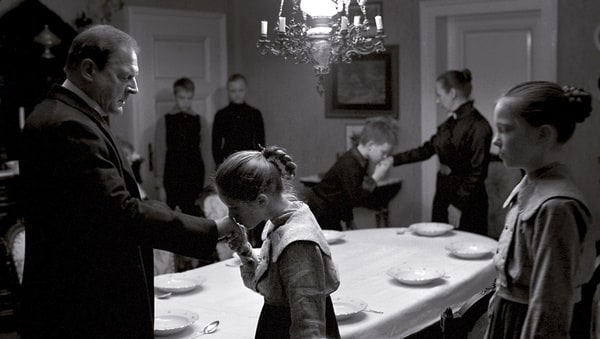Strange events happen in a small village in the north of Germany during the years just before World War I, which seem to be ritual punishment. The abused and suppressed children of the villagers seem to be at the heart of this mystery.
Christian Friedel: The School Teacher
The White Ribbon(German: Das weiße Band, Eine deutsche Kindergeschichte) is a 2009 black and white drama written and directed by Austrian filmmaker Michael Haneke. The story darkly depicts society and family in a northern German village just before World War I. According to Haneke, the film is about "the origin of every type of terrorism, be it of political or religious nature."

Set in a German village manifested by acts of malice and violence in the months leading up to the assassination of Archduke Ferdinand, Michael Haneke's latest offering The White Ribbon is a creation defined by images dually effecting and deeply insightful.
A gentle, sinless romance that builds at the center of The White Ribbon between a school teacher and a young woman named Eva (Leonie Benesch) balances the other circumstances which arise. It is from a later time and with the pangs of wisdom and helplessness that the nameless school teacher (Christian Friedel) narrates the happenings in his home village preceding the Great War.
The choice to make the film in black and white was based partly on the resemblance to photographs of the era, but also to create a distancing effect.
All scenes were originally shot in colour and then altered to black and white. Christian Berger, Haneke's usual director of photography, shot the film on Super 35 using a Moviecam Compact. Before filming started, Berger studied the black and white films Ingmar Bergman made with Sven Nykvist as cinematographer. Haneke wanted the environments to be very dark, so many indoor scenes used only practical light sources such as oil lamps and candles. In some of the darkest scenes, where the crew had been forced to add artificial lighting, extra shadows could be removed in the digital post-production which allowed for extensive retouching.
In Oberösterreichische Nachrichten, a German paper, Julia Evers called the film "an oppressive and impressive moral painting, in which neither the audience nor the people in the village find an escape and a valve from the web of authority, hierarchy and violence. Everything in The White Ribbon is true. And that is why it is so difficult to bear." Markus Keuschnigg of Die Presse praised the sober cinematography along with the pacing of the narrative. Keuschnigg opposed any claims about the director being cold and cynical, instead hailing him as uncompromising and sincerely humanistic.
Die Welt's Peter Zander compared The White Ribbon to Haneke's previous films Benny's Video and Funny Games, both centering around the theme of violence. Zander concluded that while the violence in the previous films had seemed distant and constructed, The White Ribbon demonstrates how it is a part of our reality. Zander also applauded the "perfectly cast children", whom he held as the real stars of this film.
"Mighty, monolithic and fearsome it stands in the cinema landscape. A horror drama, free from horror images", Christian Buß wrote in Der Spiegel, and expressed delight in how the film deviates from the conventions of contemporary German cinema: "Director Michael Haneke forces us to learn how to see again". Buß suggested references in the name of the fictitious village, Eichwald, to the Nazi Obersturmbannführer Adolf Eichmann and the Buchenwald concentration camp.
Eichwald is however a common German place name, meaning the "Oak Forest", thus it is open to interpretation to its meaning, if any.
''Will you set it free once it's healed?''
Reactions and effectual repercussions: The village pastor punishes his children and makes his two eldest wear the titular woven band. It is a symbol of innocence and throughout his film captures devastating cultural and historical implications; Haneke's more fervent fascination is with how innocence and sin are both entwined regarding childhood. The children all possess the basic indicators of innocence but their demeanours akin to their faces, say otherwise. What they are taught -- a strict reading of God's laws -- and what they see are dissimilar and their allegiances become first-and-foremost to God. Their imposing of His wrath takes the form of punishing not only their elders but of a rich boy and a young handicapped child.
These children would grow up and support -- if not birth -- the National Socialist movement but Haneke is careful not to corner his film or let it stand as pure symbolism. The White Ribbon is richly drawn and complexly layered in crisp and perfectly calibrated black-and-white landscapes which emphasizes shadowy house interiors and beautiful, light-drenched exteriors; A picture of immense negativity upon a foundation on a doomed community rather than a smattering of barking ideologies. The school teacher's courtship and a poor, widowed farmer's family may not be implicit in the children's surreptitious punishments but they are likewise troubled and affected by the bedlam.
Only in the film's last quarter does someone start suspecting that the children are those responsible but the viewer is meant to feel like the moral crimes perpetrated by the adults are more substantial than the atrocities committed by the children throughout. Haneke, in fact, is elliptical when it comes to acts of degrading innocence: The attacks on two boys, the murder of a cherished pet, a child's molestation and the caning of two siblings are all conveyed through their early stirrings and their ultimate effects, with interpretation and discussion adding symbolic referendum. The violence, bred from idealized indoctrination, exudes an eerie, poignant resonance retaining déjà vu and indeed, the film's pristine aesthetic, bleak with a thematic palate which help shape The White Ribbon.
The White Ribbon is simply this: Mysterious things happen. The setting of the fictitious Protestant village of Eichwald, Germany between July 1913 and August 1914, captures the feel, history and time more than any other film preceding it. It is not merely confined to being a master work of cinematography but one where storytelling and history merge together.
''There was a feeling of expectation and departure in the air. Everything was about to change.''
9/10
 Login
Login